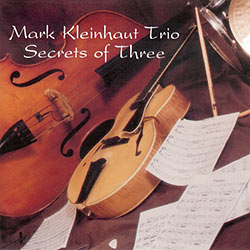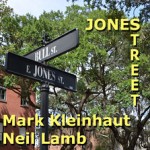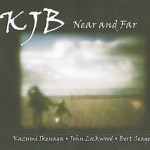Secrets of Three – Mark Kleinhaut Trio back to discography page

Tracks:
- Say That You Will 8:05
- Natasha 7:34
- Not a Poet 7:54
- Wistful 6:59
- Vacation 6:02
- Nanoprobes 4:48
- Veterans Day 5:51
- Rowboat 5:54
- Zingat 4:30
- Mark Kleinhaut, guitar
- Jimmy Lyden, bass
- Mark Macksoud, drums
All compositions copyright 2000 Invisible Music. All Rights Reserved
Guitarist Mark Kleinhaut’s new CD Secrets of Three is a stunning follow up to Amphora, his debut release on the Invisible Music label. A veteran of the New England music scene, Kleinhaut has received favorable national attention for his 1999 debut CD Amphora, which features all original compositions by Kleinhaut. Just Jazz Guitar Magazine says, “His (Kleinhaut’s) eclectic compositions are well thought out and superbly executed…Mr. Kleinhaut is capable of light-speed virtuosity…but he never lets that virtuosity overshadow the music.” Bill Milkowski of JazzTimes says Kleinhaut is, ”…a guitarist whose sheer command of the instrument is on par with the jazz elite.” And JazzImprov magazine calls Kleinhaut, “a unique voice…a welcome and refreshing “find” indeed!”
Not one to sit still, however, Mark formed a new trio in the fall of 1999 with bassist Jim Lyden and drummer Mark Macksoud. Jazz critic, S. D. Feeney, described the trio’s performance as, “This was serious, subtle, sophisticated and slightly cerebral jazz that was quietly intense and transcendently beautiful.” Now, Kleinhaut has written a new series of compositions, which explore the interactions of the trio format and the secrets these interchanges reveal. The resulting album is Secrets of Three, release date August 4, 2000.
Excerpts from the liner notes:
Lately, I’ve been thinking about things in three. Of triads and trilogies and how good and bad things all come in threes. Our myths and science throughout the ages have had much to say about the mystery of the number three. Our stories have beginnings, middles and endings just as our lives play out in the phases of youth, middle & old-age. In our three dimensional physical world matter exists in a solid, liquid or gaseous state. Even the great mystery of time itself exists in the past, present and future. And within time–in the present moment that is but an instant in the vast expanse of past and future–music lives.
Iwe tend to think of the world as binary. And it remains true that dualities and polarities can aptly describe all things in the world, as yin and yang, on and off, everything and nothingness. But in between there exists a middle point, or moment of transition. At this point of juncture, however infinitesimally small, yin and yang coexist as equals; both present but neither present. At this time, the weightless inertia of the righting moment, things can go either way. At this point, our decisions really count.
In the context of this trio ensemble, the musical trinity of melody, harmony and rhythm take up the eternal dance. From beginning to middle to end, we seek the moments of transition between the classical musical forms expressed conventionally as dualities: tension and release, staccato and legato, slow and fast, ascending and descending. But listen for the spaces in between these opposites, when the music begins to change, but where it has not yet transformed, where it is simultaneously both and neither.




